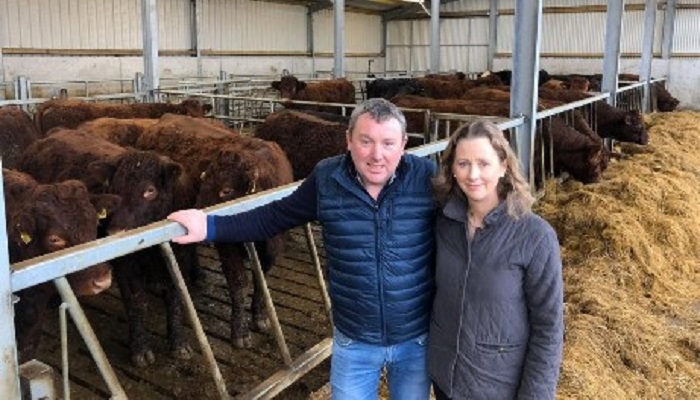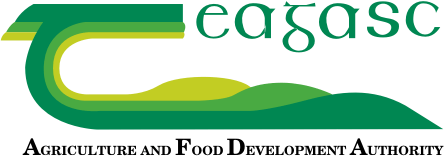25 March 2024
Slow and steady approach delivers for suckler herd fertility

The correct breeding policy lays the foundation for profitability within suckler systems. Once you get it right, you are heading in the right direction.
A successful suckler breeding policy is underpinned by a number of key performance indicators (KPIs), which – when achieved – deliver increased efficiency and profitability. These include:
- Achieving one calf per cow per year;
- Low levels of mortality – <2%;
- A 365 day calving interval;
- Compact calving – targeting 80% of cows calving within a 6 week window
- Calving at two years of age.
Shane Keaveney, who operates a suckler farming system in Co. Roscommon, joined the recent Future Beef Webinar: Journey to Profitability, where he outlined how he has targeted these key metrics to improve the performance of his suckler herd. Shane has worked to reduce the calving interval of his herd significantly, calves per cow per year have increased and 97% of his cows calved in a six week window in 2023.
Table 1: Key performance indicators of Shane Keaveney’s herd
| Key performance indicators | Shane’s herd (2014) | Shane’s herd (2023) | National average (2023) |
|---|---|---|---|
| Calving interval (days) | 437 | 360 | 390 |
| Mortality – dead at birth (%) | 0 | 0 | 0.91 |
| Mortality – dead at 28 days (%) | 0 | 0 | 2.23 |
| Calves per cow per year | 0.77 | 1.07 | 0.87 |
| % of heifers calves 22-26 months of age | 25 | 100 | 23 |
| 6 week calving rate | 83 | 97 | 56 |
The focus on improving his herd’s key performance indicators gathered pace in 2017, when Shane made the decision to enter suckler farming on a full-time basis. For this arrangement to work, it had to be profitable and streamlined to make sure everything ran smoothly, thus came the decision on suckler cow type.
“I always knew I needed to get the cow type right,” Shane explained. “There was no point going with a very terminal bull on cows that weren’t able for it. I went with Salers because they have a wide pelvis. I’ve found them very good mothers and they’ve good milk.”
Once the cow type was confirmed, the next step was tightening the calving interval – moving from 437 days in 2014 to 360 days in 2023. Now, the calving period extends from February through to early April, with the majority of the cows calved in a six-week window this spring. The calving season had previously ran into May, but he found that this was leaving a light weanling at housing, forcing them to be housed over the winter months and turning them into a very expensive calf.
To achieve these improvements, a focus was first placed on shortening the length of the breeding season to 12 weeks, before moving to his target of 10 weeks.
“If we decided to bring it down to 10 weeks too soon, we would have had an awful lot of cull cows and I didn’t want that because I was busy building the herd,” Shane said.
“Believe it or not, we didn’t lose that many cows along the way by doing it a bit slower because we were just tightening it by a couple of weeks every year until we got to where we are.”
Commenting further on the improvements to the six week calving rate and calving interval, Shane said: “Keep it simple. If you are not where you want to be, make a five year plan and work away at it for five years. You are not going to reduce your calving interval over night; don’t think you can.”
Calving at 24 months
Calving at 24 months is not only a strategy to improve the profitability of suckler farming enterprises, but it also has environmental benefits, as suckler replacements are productive a year earlier in life. The scope for improvement in this area is huge nationally, with just 23% of suckler replacements calving between 22 and 26 months in 2023.
Shane’s take on calving heifers at 24 months of age is interesting. He prefers them to calve towards the middle to the end of the calving season to shorten the lag time between calving and the turnout to grass. This, he feels, maintains the condition of the heifers and helps during the breeding season. There’s no doubt that this strategy is working. Of the heifers that calved for the first time in the herd in 2023, all have calved this spring and their average calving interval was 355 days. Central to the success of this policy is ensuring replacements are at a suitable weight at the start of the breeding season, with 380kg being the target for Shane, stemming from a mature cow weight of 655kg.
A barrier to calving at 24 months of age often quoted by opposers is the performance of the calf. On this, Shane said: “When I first started off, you would always pick out a heifer’s calf at weaning. Over the last couple of years, I have bred off heifers’ heifers; they were hitting their target weights and heifers’ calves are still doing the business as under 16 month bulls.”
Breeding strategy and sexed semen
Shane also delved into the breeding strategy in play on the farm. After receiving bad prices in two concurrent years for Saler weanling bulls, he decided to introduce a Charolais stock bull and focus more on under 16 month bull production. This posed another problem in that unsuitable replacements were being generated. Now, Shane picks out 7-8 of his best cows and mates them to maternal AI to generate heifers. Sexed semen has also been used to mixed results. In the first year, Shane was happy with how sexed semen worked on his farm, but he blamed hot weather during the breeding season last year for its limited success.
When asked would he continue with sexed semen, he said: “I’ve had one good year and one bad year with sexed semen and I haven’t ruled it out
“For a herd my size that can’t justify two stock bulls, sexed semen has the potential to be a game changer really. That’s my belief. If I can get some really good maternal replacements through using sexed semen and still have a very terminal stock bull there, I think it has huge potential,” Shane said.
View the Future Beef Webinar: Journey to Profitability here
More on Shane Keaveney’s farming system
